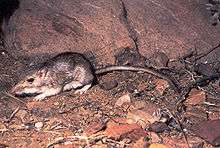Bailey's pocket mouse
Bailey's pocket mouse (Chaetodipus baileyi) is a species of rodent of the subfamily Perognathinae, family Heteromyidae.[2] It is found in Baja California, Sinaloa and Sonora in Mexico and in California, Arizona and New Mexico in the United States.[1]
| Bailey's pocket mouse | |
|---|---|
 | |
| Scientific classification | |
| Kingdom: | Animalia |
| Phylum: | Chordata |
| Class: | Mammalia |
| Order: | Rodentia |
| Family: | Heteromyidae |
| Genus: | Chaetodipus |
| Species: | C. baileyi |
| Binomial name | |
| Chaetodipus baileyi (Merriam, 1894) | |
Description
Bailey's pocket mouse has an adult length of between 176 and 240 mm (6.9 and 9.4 in), males being larger than females. Males average 28.2 g (1.0 oz) while females average 24.5 g (0.86 oz).[3]
Taxonomy
Bailey's pocket mouse was first described by Clinton Hart Merriam in 1894 using a specimen collected by Vernon Bailey in Magdalena, Mexico on 3 November 1889.[4]
Ecology
This pocket mouse lives in a burrow and is nocturnal. When it ventures into the open to search for food it is cautious, remaining as far as possible under cover or in the shadow of plants. When the risk of predation by owls is high it tries to avoid crossing open ground between shrubs, especially on moonlit nights.[1] Pocket mice feed on seeds which they carry in fur lined pouches on the outside of their cheeks, taking them back to their burrow for storage; this arrangement is advantageous to the mouse as it prevents the seeds from getting wet as would happen if they were carried in the mouth. Bailey's pocket mouse is the only known animal to be able to digest the wax found inside the jojoba nut and is the only rodent from the Sonoran Desert that is able to eat the seeds, because they are poisonous to most other mammals.[3]
In the 1970s, researchers removed kangaroo rats from an ecosystem in the Chihuahuan Desert, and for many years, no other small rodents moved in to fill the niche they left. In 1995, twenty years after the experimental removal, Bailey's pocket mouse moved into the area and filled the gap, almost completely replacing the missing kangaroo rats.[5]
Status
Bailey's pocket mouse varies in abundance between about two and eighty animals per hectare, depending on the amount of rainfall and hence on its food supply. No particular threats to this species have been identified, and the International Union for Conservation of Nature has listed its conservation status as being of "least concern".[1]
References
- Linzey, A. V.; Timm, R.; Álvarez-Castañeda, S. T. & Lacher, T. (2008). "Chaetodipus baileyi". IUCN Red List of Threatened Species. 2008. Retrieved 29 July 2016.CS1 maint: ref=harv (link)
- Patton, J.L. (2005). "Family Heteromyidae". In Wilson, D.E.; Reeder, D.M (eds.). Mammal Species of the World: A Taxonomic and Geographic Reference (3rd ed.). Johns Hopkins University Press. p. 853. ISBN 978-0-8018-8221-0. OCLC 62265494.
- "Chaetodipus baileyi". North American Mammals. Smithsonian. Retrieved 29 July 2016.
- Merriam, C. H. (1894). "Descriptions of eight new pocket mice (genus Perognathus)". Proceedings of the Academy of Natural Sciences of Philadelphia. 46: 262. ISSN 0097-3157 – via Biodiversity Heritage Library.
- Ernest, SK; Brown, JH (2001). "Delayed Compensation for Missing Keystone Species by Colonization". Science. 292 (5514): 101–104. doi:10.1126/science.292.5514.101. PMID 11292873.
